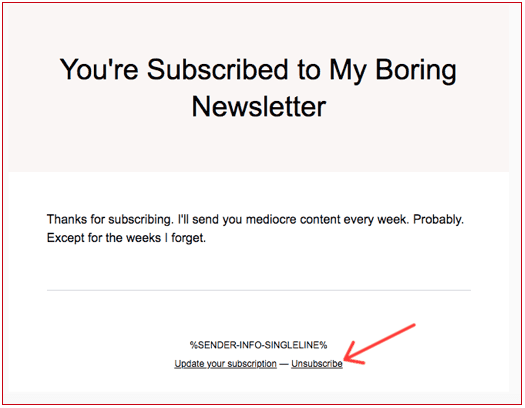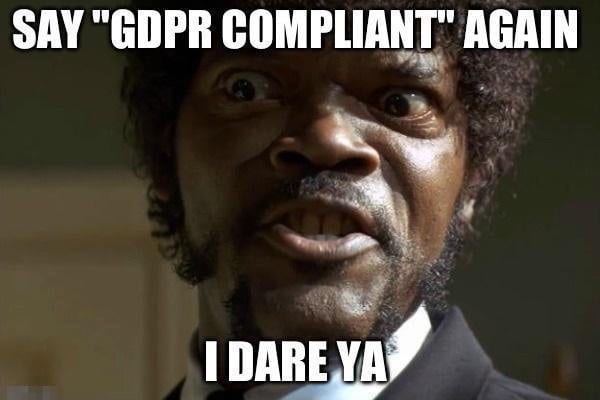Traditionally, list building was an e-mail marketing thing. It still is to an extent, but there’s so much more that you need to consider now.
Now you can use your customer lists to target subscribed (opted-in) users across multiple platforms including LinkedIn, Google Display Network, Google Search, Facebook and Instagram.
The term ‘list-building’ in itself even implies a list of email addresses that is, at best, sorted alphabetically.
A few years ago, it typically amounted to a ‘Sign Up For Our Newsletter’ field on a website, after which you may – nor may not – get some useful stuff.
Customer lists are a very powerful tool that is under-utilised. It’s like blindfolded archery – you don’t know what you’re missing! Many of you will know this, but there are VERY few brands doing this right.
We’ll get to that, but let’s first take a look at how to get started.
Target them later
I’m not concerned about signing up for newsletters and I’ll do so when I’m pretty sure that I might get something of value. Privacy is not usually a concern for me because I’m not “offended” when I’m targeted with relevant ads. Or an irrelevant one, for that matter.
I’m also comfortable enough to unsubscribe when the first e-mail I receive begins with ‘Dear [NAME]’, or if it’s just plain rubbish.

And given that I am happy to take personal responsibility for my own privacy, you can assume that I am not alone. Users are comfortable to sign up. So be good to them, and then you can target them later across multiple platforms with very specific advertising.
I have personally worked with clients who had up to a 5% conversion rate for newsletter signups, so 1 in 20 people were comfortable enough to do so. But beyond this, nothing was being done to segment and target those as they went about their everyday.
These are people who have explicitly said: “Yes, I want to hear more from you.” That’s the strongest audience that you can get. That’s something valuable for anyone to achieve and it’s also very powerful. Yes, many brands will e-mail them. But most are not nurturing that relationship by taking it out of their Inbox.
Typically, a good basic e-mail strategy will adhere to several simple things:
- Give a taster of what to expect
- Give clear reasons for them to sign up
- Be clear about what they will receive
- Compose a beautiful personalised welcome e-mail
- Do not surprise them by pushing products or services unless expected
- Give them some interesting, original content
- Always be honest and sincere in all your communications, and you will always make a good impression with customers.
What’s usually missing is that once they have signed up, you will want to segment them based on the information you have about them. There’s e-mail marketing software for doing this but there’s nothing to prevent SMEs from doing this manually and in a way that is GDPR-compliant. And then you can target them with relevant advertising.
You will have a location, gender and any other information that you have asked for at signup, and you should also have their website behaviours. So if you want to show ads on Facebook to female prospects aged 25-35 in Dublin who are interested in buying necklaces but haven’t done so yet – you can do it.
It’s important to note here that having a tickbox next to your signup does not make you GDPR compliant. Only good business practices can do that. A tickbox does not get you out of jail for free.

That’s enough about e-mail marketing. Those are the basics, the requisites that you should absolutely be doing anyway. If you’re not, then give us a call before continuing on to the next part.
The next part
So now you’ve got your list of newsletter subscribers and online purchasers. You’ve got them segmented nicely. Let the fun begin.
Firstly, you can upload these lists to the Facebook/Instagram Ads platform. This will allow you to re-target them based on their interaction with your brand – recency of purchase, non-purchasers, etc. This can be a very powerful cross-selling tool.
Using these lists you can also create Lookalike Audiences. Facebook will find users with similar interests and behaviours to those you have uploaded and you can then target them. For example, you can find people just like those who have recently purchased from you. We’ve done this. A lot. It works very well.
There are other ways in which this can be useful. If you have properly segmented your customer lists then you can also use these to exclude those that you do not wish to target. This can prove to be useful when you know what category of products a user is interested in, so you do not want to show it to those who are not.
LinkedIn has also improved this functionality within their platform. In this case, you can upload your contacts list – in the B2B space, this is commonly a prospects list – and specifically, target them with ads.
Using LinkedIn, you can also upload a list of company names. Which means that you can target every company in your sector while you exclude everyone in your own from seeing those ads.
We are currently using these tactics on LinkedIn for a global client and maintaining a very healthy 7% conversion rate.

Great opportunities
On Google’s platforms, you can have control over which audiences see your ads across YouTube, Gmail, Google Search, and the Google Display Network through remarketing campaigns – and this includes the e-mail lists that you upload. This presents some great opportunities, including:
- The ability to bid higher and be front and centre for prospects who have been in touch but did not convert yet.
- You can exclude current customers from all targeting if you wish.
- Promote your new app to current customers.
- Only pay for brand clicks from new customers (note: this one is great)
Using these techniques. You can, in short, better tailor your Google campaigns to target more qualified and valuable users who are already aware of you – and get them over the line.
Your mind may be coming full circle here back to GDPR and privacy because I’ve covered a lot about targeting individuals. Well, that might be because that’s a topic that has been often misinterpreted.
As I mentioned earlier, your business needs to be GDPR compliant (there, I said it again), not just your website. And furthermore, these platforms use encryption on the information that you upload. In Google’s case, they use something called SHA-256. (designed by the NSA, no less), and your customer is matched using the encrypted data, not the uploaded email or phone number.
To be clear, you can do everything I’ve just talked about and be compliant. So there’s nothing stopping you.
So, what now?
Have a clear and enticing call-out on your website for users to subscribe.
Give them reasons to.
Now what you need to do is think about your content and your promotions calendar. Think about lining up 6-12 months of activity so that you can give users a reason to stay engaged.
The next step is simple…
Get in touch with Friday Agency and let us show you what we can do.


